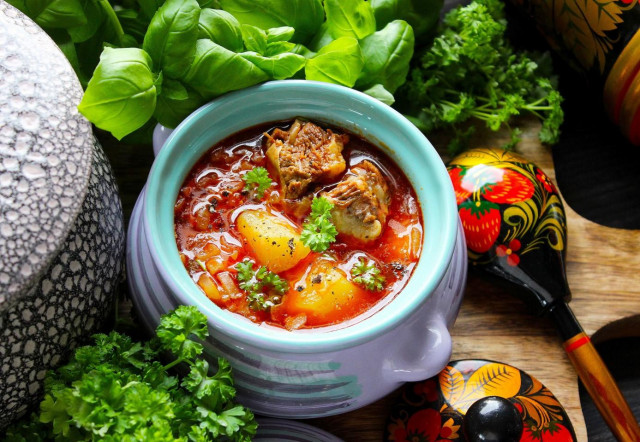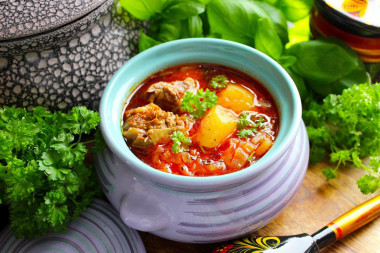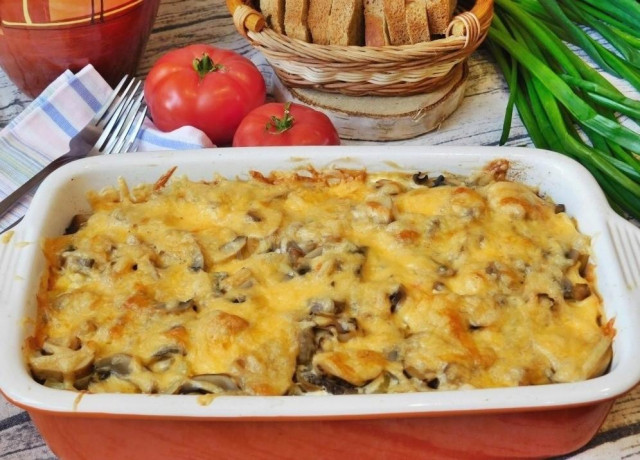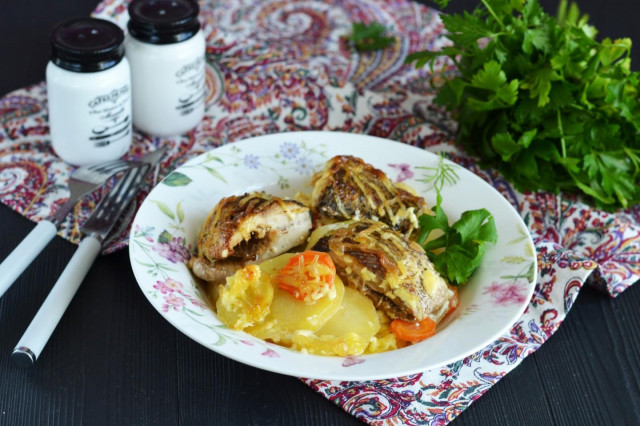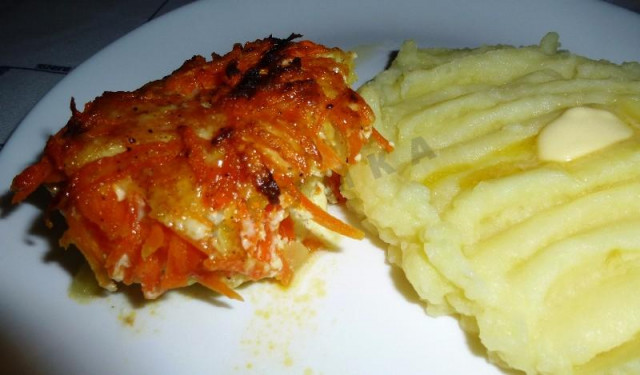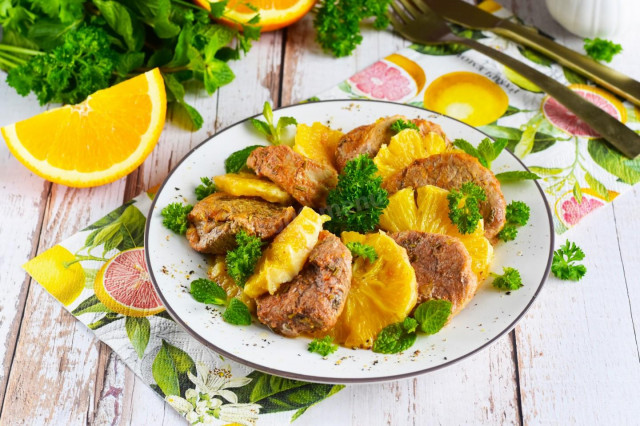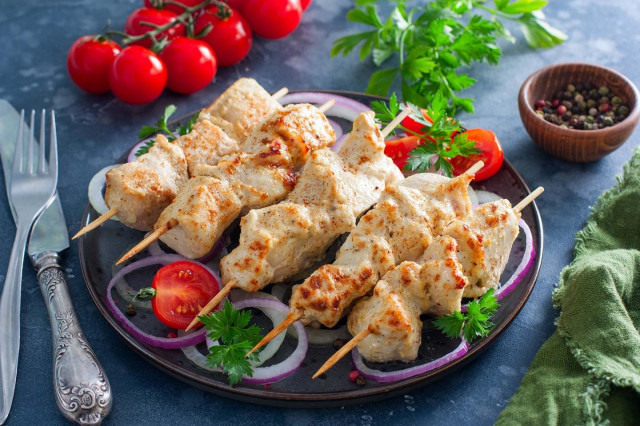Composition / ingredients
Step-by-step cooking
Step 1:
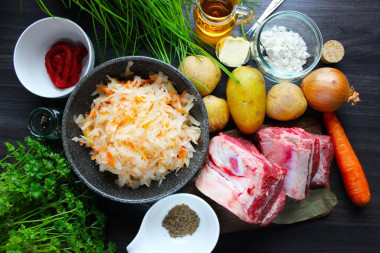
How to cook cabbage soup from sauerkraut in the oven in a pot? Prepare all the products needed for the recipe. Any meat can be used. A particularly delicious soup will be made from beef on the bone. Cabbage can be used sauerkraut with carrots, or without carrots.
Step 2:
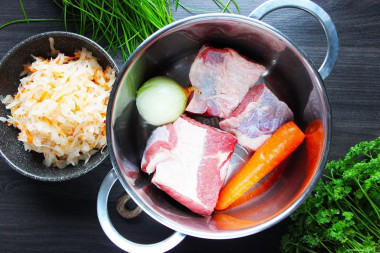
Peel the onion and carrot and rinse. Wash the meat under running water. In a saucepan, send the meat, one onion and a carrot. Fill with cold water and put on the stove over high heat. After boiling, remove the formed foam, reduce the flame to a minimum and cook the broth for about 1- 1.5 hours. Next, remove the meat, cool slightly and cut into small pieces. Remove the onion and carrot from the broth.
Step 3:

Put cabbage, butter, tomato paste, cumin and dill seeds in a frying pan with a thick bottom. Mix thoroughly and simmer on low heat under a closed lid for 30 minutes. Periodically open the lid, mix everything and check if the cabbage burns. If necessary, add 1-2 tablespoons of boiling water.
Step 4:
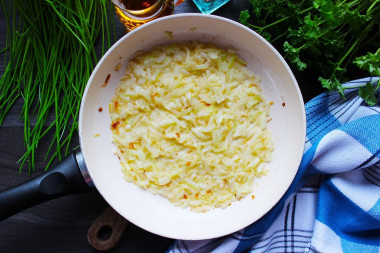
In a separate frying pan in vegetable oil, pass the second onion, chopped finely, until transparent. Add the flour and cook for a few more seconds, stirring constantly.
Step 5:

Peel the potatoes, rinse and cut into large pieces.
Step 6:
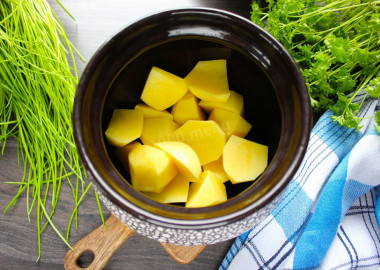
Put the potatoes on the bottom of the clay pot (or cauldron).
Step 7:

Then beef and fried onions.
Step 8:
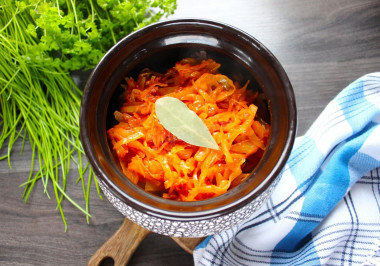
Add cabbage and bay leaf to the pot. Pour over the broth. Do not pour the broth to the very edges, otherwise it will pour out of the pot during cooking.
Step 9:
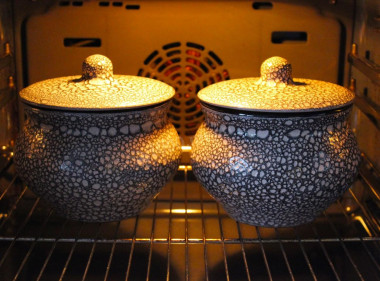
Put the soup in a preheated oven. At 180-200 degrees, bring to a boil and reduce the oven heat to 150-170 degrees. Cook soup for about 1.5 - 2 hours, focus on the capabilities of your oven and the readiness of potatoes. It is important that the broth should not gurgle intensely. Soup in pots should languish.
Step 10:

Rinse the greens and chop them finely.
Step 11:

Add the herbs and chopped garlic to the finished soup.
Step 12:

Can be served immediately or leave ready-made soup in the cold overnight. When serving the soup, offer fresh sour cream and ground allspice.
For the preparation of cabbage soup, I used cabbage fermented in an oak barrel,
according to this recipe
.
How much water should I take to make broth? The amount depends entirely on your taste preferences. I used a little less than 2 liters for the specified number of products. Stewed cabbage soup in two pots each with a volume of 1-1.5 liters.
At the end of cooking, try the soup with salt and add salt if necessary. I usually don't add salt, as sauerkraut is salty by itself.
Bon appetit!
Important! Regardless of whether the amount of water for soup is indicated in the recipe or not, it is best to focus on your own preferences (thick or more liquid soup you like), as well as on the size of your pan and the products taken for cooking. Do not forget that the author has his own view on the amount of meat, potatoes, cereals and other ingredients in the soup, which may not coincide with yours. In practice, this means that if you are cooking for the first time, you should not cook a whole pot at once. Make a soup for tasting - for one or two people. To do this, reduce the amount of all ingredients according to the recipe to 1-2 servings, and take the amount of water from the calculation: from one glass per serving - if the soup is very thick, to 1.5-2 glasses - if more liquid. Do not forget to take into account that part of the liquid will boil off during the cooking process. After tasting a small portion of soup, you can adjust both the amount of liquid and the proportions of ingredients to your taste. In the future, like most experienced housewives, you will be able to pour water for soup and lay the ingredients “by eye".
For this recipe, it does not matter which part of the carcass to choose, since it will still become soft during cooking.
Keep in mind that everyone's ovens are different. The temperature and cooking time may differ from those specified in the recipe. To make any baked dish successful, use the useful information about the features of the ovens !
Caloric content of the products possible in the composition of the dish
- Onion - 41 kcal/100g
- Ripe potatoes - 80 kcal/100g
- Baked potatoes - 70 kcal/100g
- Mashed potatoes - 380 kcal/100g
- Boiled potatoes - 82 kcal/100g
- Potatoes in uniform - 74 kcal/100g
- Fried potatoes - 192 kcal/100g
- Melted beef fat - 871 kcal/100g
- Fat beef - 171 kcal/100g
- Lean beef - 158 kcal/100g
- Beef brisket - 217 kcal/100g
- Beef - okovalok - 380 kcal/100g
- Beef - lean roast - 200 kcal/100g
- Beef shoulder - 137 kcal/100g
- Beef - ribs - 233 kcal/100g
- Beef - ham - 104 kcal/100g
- Beef - tail - 184 kcal/100g
- Boiled ham - 269 kcal/100g
- Beef corned beef - 216 kcal/100g
- Carrots - 33 kcal/100g
- Dried carrots - 275 kcal/100g
- Boiled carrots - 25 kcal/100g
- Garlic - 143 kcal/100g
- Bay leaf - 313 kcal/100g
- Ground black pepper - 255 kcal/100g
- Dill greens - 38 kcal/100g
- Whole durum wheat flour fortified - 333 kcal/100g
- Whole durum wheat flour, universal - 364 kcal/100g
- Flour krupchatka - 348 kcal/100g
- Flour - 325 kcal/100g
- Cumin - 333 kcal/100g
- Butter 82% - 734 kcal/100g
- Amateur unsalted butter - 709 kcal/100g
- Unsalted peasant butter - 661 kcal/100g
- Peasant salted butter - 652 kcal/100g
- Melted butter - 869 kcal/100g
- Vegetable oil - 873 kcal/100g
- Tomato paste - 28 kcal/100g
- Sauerkraut - 19 kcal/100g
- Fresh frozen soup greens in a package - 41 kcal/100g
- Greenery - 41 kcal/100g

